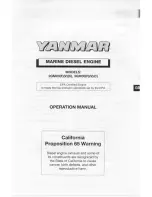
Instructions for use and maintenance
Electric motors 75-200 V DC
initially send an audible or visual signal to the operator, and only at a later stage, if the
operator has not intervened, can it be stopped. Naturally, intervention levels and delay times
should be chosen in such a way as to exclude possible hazardous conditions.
In the case of motors powered by converters (e.g. inverters), protection may also be provided
by limiting the current consumption; this limitation, however, is generally set at a value higher
than the rated current in order to allow the motor to withstand any peak load and have
sufficient starting torque. Therefore it must be coupled to another device able to intervene in
the case of over a certain time of overload conditions for the motor.
•
Interruption or decreasing of the supply voltage.
Where a voltage drop or interruption is likely to cause a malfunction of the electrical
equipment, a minimum voltage device shall be provided to ensure appropriate protection (for
example, the interruption of the machine
’s power supply) a
t a predetermined voltage level. If
the operation of a machine can withstand an interruption or a voltage reduction for a short
period, a delayed minimum voltage device may be provided. The operation of the minimum
voltage device must not impair the operation of any machinery stop control.
•
Excessive speed of machine elements.
Any over-speed of the motor may occur in the case of power supply by means of converters,
following a failure or abnormal operation of the converter itself, or in the case of dragging by
the load, in the case of absence or insufficiency of braking action. Protection, which is essential
when over-speed can cause dangerous conditions, can be obtained by preventing such
abnormal operations, for example by the use of devices sensitive to motor speed (centrifugal
switches or voltage relays connected to tachymetric dynamos), interrupting the power supply
of the motor, possibly including braking devices, in the event that the power failure is not able
to stop the controlled load (e.g.: uplift).
•
Protection against direct contact.
To avoid direct contact, the active parts of the motor (which are normally live) are placed
inside the casing (motor casing) and the opening of the terminal box, which makes them
accessible, and made possible only through the use of a tool. The removal of the terminal box
must be carried out, in case of maintenance, only by qualified experienced personnel with
visibly sectioned power supply network, including auxiliary circuits (e.g. for anti-condensation
treads) so as not to have accessible live parts.
In the case of active parts capable of maintaining the voltage, such as mains capacitors visibly
disconnected, drain the capacitors before performing any other intervention.
•
Protection against indirect contacts.
The protection against indirect contacts, that is, the contacts due to the manifestation of faults
in the insulation which thus bring the external metallic masses in contact with active parts
under tension, is mainly achieved by connecting all accessible masses to a protective
conductor, which in turn is connected to the ground, and by using protective devices which act
by disconnecting the power supply when, due to the fault in the winding, the passage of
currents towards the ground occurs.
Page
14
of
19






































